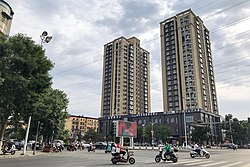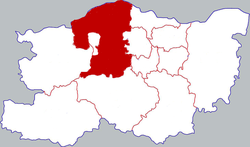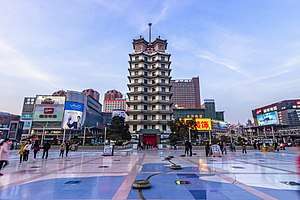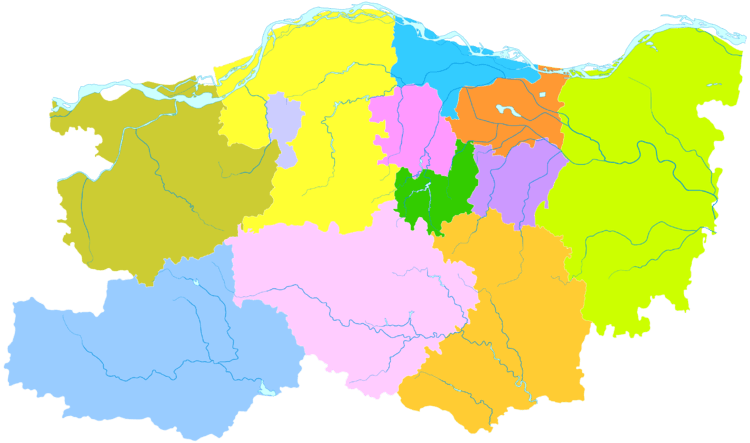Xingyang
Xingyang (simplified Chinese: 荥阳; traditional Chinese: 滎陽; pinyin: Xíngyáng), is a county-level city of Henan Province, South Central China, it is under the administration of the prefecture-level city of Zhengzhou. It is situated 15 kilometers to the west of Zhengzhou city proper. The population of Xingyang is around 590,000 and the area of Xingyang is about 908 km2 (351 sq mi).[1]
Xingyang 荥阳市 | |
|---|---|
 Xingyang in May 2020 | |
 Location in Zhengzhou | |
 Xingyang Location in Henan | |
| Coordinates (dm): 34°47′N 113°21′E | |
| Country | People's Republic of China |
| Province | Henan |
| Prefecture-level city | Zhengzhou |
| Area | |
| • Total | 908 km2 (351 sq mi) |
| Population | |
| • Total | 590,000 |
| • Density | 650/km2 (1,700/sq mi) |
| Time zone | UTC+8 (China Standard) |
| Website | www |
Administration
The county-level city of Xingyang administers 16 township-level divisions, including 9 towns, 3 townships, 1 ethnic township, 2 sub-districts and 1 landscape division.
- Suohe Subdistrict (索河街道)
- Jingcheng Subdistrict (京城街道)
- Chengguan Township (城关乡)
- Qiaolou Town (乔楼镇)
- Yulong Town (豫龙镇)
- Guanwu Town (广武镇)
- Gaocun Township (高村乡)
- Wangcun Town (王村镇)
- Sishui Town (汜水镇)
- Gaoshan Town (高山镇)
- Liuhe Town (刘河镇)
- Cuimiao Town (崔庙镇)
- Jiayu Town (贾峪镇)
- Jinzhai Hui Ethnic Township (金砦回族乡)
- Beimang Township (北邙乡)
History
The name of Xingyang, coming from Shangshu, means the city located in the north of Xing River (荥). The history of Xingyang can be retrieved in books written more than 3,000 years ago.
It is believed in Chinese legend that Xingyang is the place where Chang'e flew to the Moon. In addition, many influential persons in Chinese history were from Xingyang, such as Shen Buhai, a legalist in the Warring States period) and Li Shangyin (a poet in late Tang Dynasty). Moreover, Xingyang is considered as the origin place of the people whose surname is Zheng (郑氏) in the world.
Xingyang is home to remains from the Han dynasty.[2]
Buddhist antiquities have been found there.[3]
Economy
In 2004 the GDP is ¥ 14.5 Billion, and the GDP per capita is ¥ 23,387.
Located on the flat southern bank of the Yellow River, Xingyang's Wangcun Town is known for its aquaculture. Since their development started in 1986, the pond systems in Wangcun have grown to the total size of 15,000 mu (10 km2), making the town the largest aquaculture center in North China.[4]
In 2007, construction started in Wangcun on a large turtle farm raising the Yellow River Turtle (a local variety of the Chinese softshell turtle). With the capacity for raising 5 million turtles a year, the facility was expected to become Henan's largest farm of this kind.[5]
Transportation
Travelling within the city is convenient and cheap by bus or taxi. In 2005, the start fee of Taxi for the first 3 kilometres is about ¥ 4, and the cost for every additional kilometre is ¥ 1. Fares are generally somewhat higher during 10 pm to 6 am. Normally ¥ 6-7 is maximum for traveling in the city Xingyang. The Zhengzhou West Railway Station is located in Xingyang.
Tourist attractions
- Chuhehanjie (楚河汉界, or Hong Gou) is a famous place in early Western Han Dynasty where Liu Bang, the creator of Western Han Dynasty, fought for years with his rival, Xiang Yu. Because none of them could win after years, they decided to use the Chuhehanjie to divide China into two parts, with the eastern part to Xiang Yu and western part to Liu Bang after negotiation. Liu Bang broke this agreement later when Xiang Yu retreated from Xingyang to rescue the capital of his territory, which was attacked by Han Xin. The border between the two is commonly referenced in Xiangqi (i.e., Chinese chess) as the symbolic divider between the two sides of a game board.
- Hulao Pass is an important site in Three Kingdoms Period where Lü Bu fought with Liu Bei, Guan Yu, and Zhang Fei.
- The Ruins of Yangshao civilization (仰韶文化遗址)
- Huancuiyu Landscape area
Agricultural products
- Xingyang dried persimmon
- Guangwu Megranate
Notable residents
The hometown of the character Zheng (T: 鄭, S: 郑) from The Tale of Li Wa is Xingyang.[6]
References
- (in Chinese) Profile of Xingyang Archived May 12, 2008, at the Wayback Machine, Official website of Xingyang Government, visited on April 12, 2008.
- Qinghua Guo (2010). The Mingqi Pottery Buildings of Han Dynasty China, 206 BC-AD 220: Architectural Representations and Represented Architecture. Sussex Academic Press. pp. 201–. ISBN 978-1-84519-321-8.
- Dorothy C. Wong (January 2004). Chinese Steles: Pre-Buddhist and Buddhist Use of a Symbolic Form. University of Hawaii Press. pp. 101–. ISBN 978-0-8248-2783-0.
- 黄河畔的荥阳市万亩鱼塘 (Ten thousand of mu of fish ponds in the riverside Xingyang), 2011-09-30
- 荥阳开建河南省最大黄河鳖养殖基地 (Construction started in Xingyang on the province's largest Yellow River Turtle farm), www.zynews.com, 2007-07-24
- Nienhauser, William H. Jr. (University of Wisconsin-Madison). "A Third Look at "Li Wa Zhuan"." T'ang Studies (Print ISSN 0737-5034, Online ISSN 1759-7633), 2007(25), pp. 91–110. -- Cited: p. 100.
External links
- Official website of Xingyang Government (in Chinese)

